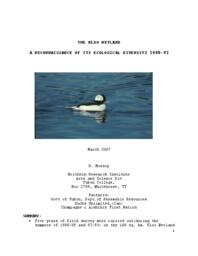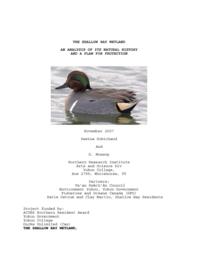Ducks Unlimited Canada
Related Works
Content type
Digital Document
Description / Synopsis
The Kloo Wetland is an area of approximately 100 sq. km. of just over 340 small to medium sized ponds and lakes associated with the floodplain of the Jarvis River in the South Western Yukon. It includes two larger lakes, Kloo and Sulphur, and is about 30 km NW of the village of Haines Junction, YT. In 1980, an area of 447 sq. km. including the wetland was identified as ‘critical’ wildlife habitat by map notation for Land Use decision purpose (Yukon Waterfowl Management Plan, 1985, 1990). This designation was based simply on the obvious concentration of waterbodies and the area’s known value to wildlife species and to local people.
Origin Information
Content type
Digital Document
Description / Synopsis
Shallow Bay is a 230 hectare wetland at the south end of Lake Laberge in the southern Yukon. It has been central to the original use of the area by the Ta’an Kwachan first nation. It is an important waterfowl staging area; a key fish spawning and rearing area, and is used by moose, beaver, bear, mustelids, muskrats and a host of bird species. We found 36 species of water birds using the area; banded waterfowl showed birds from all North American flyways except the Atlantic were using the area. Most use by water birds was for staging although at least 4 species were breeding. Over 100 species of songbirds were observed and at least 17 species were breeding. Wood frogs, and 9 species of fish were identified. 6 species of birds of prey were found hunting in the wetland; only N.goshawk was found breeding. The vegetation community consists of three major zones: aquatic, emergent and riparian periodically flooded shrub. Water of the bay is mostly from the one small inflow creek, Horse Creek, although annually silts from the major Yukon drainage contribute to the benthics of the wetland. Critical to the area’s ecology is the hydrologic regime of annual flooding of the emergent and riparian shrub zones. The flooded riparian zones are heavily used by brood rearing water birds and by many thousands of young fish. Benthic and aquatic invertebrates represent much of the area’s biomass. Protection measures and planning for the areas future must include controlling recreational use (including hunting, and motorized access), managing its unique water level regime, protecting its water inflow, and supporting is obvious considerable educational values. A legally protected habitat area will probably be required to ensure the critical process of the area continue in perpetuity.
Origin Information


